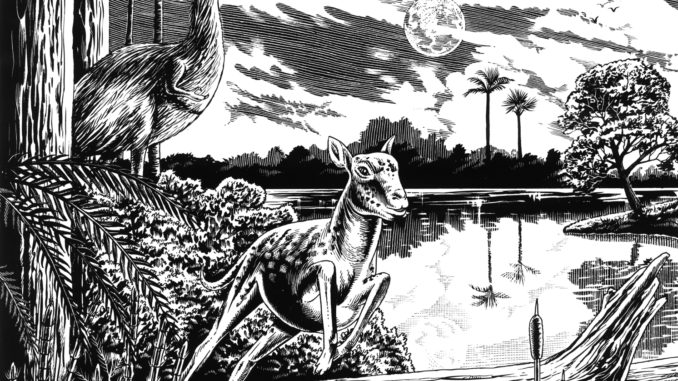
Bio Bites
By R. Gary Raham
A biologist-artist’s ruminations about our roles in a science-inspired world
Scientists recently discovered a treasure trove of rocks near Colorado Springs with an important story to tell: the origins of all the warm and furry mammalian creatures (including humans) that we hold near and dear. I actually know several of the players in this story. Some of them are citizen scientists whose passion for learning about the deep past puts them in the field where new fossil discoveries may appear with one tap of a rock hammer.
We take our modern world filled with mammals and flowering plants for granted. It only came into existence after a catastrophic disaster that wiped out three out of every four creatures on the planet. That disaster came in the form of a six-mile long asteroid that plummeted to Earth in what is now Northern Mexico 66 million years ago, first roasting the world in fire, and then freezing it under a sun-shielded blanket of clouds and atmospheric debris. The asteroid impact reset the Earth’s biosphere. Established plant communities and anything much larger than a field mouse disappeared.
Fortunately, there were things about the size of field mice: our distant ancestors. There were also plants that bore seeds capable of surviving fire and ice: the flowering plants. It was their time to build a new world.
Finding the remains of that world has always been nearly impossible. Small animals have tiny, fragile bones, and teeth the size of pinheads. Kirk Johnson, who designed the Prehistoric Journey exhibit at the Denver Museum of Nature and Science (DMNS), and who is currently the Director of the Smithsonian’s National Museum of Natural History in Washington D.C., said in a recent NOVA PBS feature that he hunted fossils for 35 years and only found two early mammal bones. (https://www.pbs.org/wgbh/nova/video/rise-of-the-mammals/) At Corral Bluffs near Colorado Springs, paleontologist Tyler Lyson and paleobotanist Ian Miller found half a dozen post-apocalypse mammal skulls within ten minutes—once they knew precisely what to look for.
DMNS volunteer Susan Milito provided that knowledge. Years before, she had found a concretion—a ball of rock that was once mud and sand—at Corral Bluffs that had enclosed the remains of a mammal skull. She donated it to the museum collection where it remained until discovered by Tyler Lyson, a (mostly) dinosaur scientist with a strong interest in the boundary between “Dinosaur World” and “Mammal World.” Lyson enlisted Miller to help him scour the Bluffs for more concretions and identify any plants they found. They found both—in quantity. Corral Bluffs, they now know, is a world-class site that is revealing the intricate details of the first million years after the asteroid apocalypse in great detail.
Another avid amateur, Shellie Luallin, prepared 3D images of some of the amazingly preserved skulls already found. You can see them at https://coloradosprings.dmns.org/the-mammals/ (Scroll down the page.)
If you can’t enjoy the thrill of discovery directly in the field, the next best thing is to explore the treasures housed in the vaults and shelves at the Denver Museum. Some of those treasures just need an experienced eye to recognize their complete value. In this case, that includes the knowledge of how the world we know began.
DMNS is currently displaying fossils from Corral Bluffs on Level 1 of the museum (https://coloradosprings.dmns.org/visit-the-exhibition/)
Support Northern Colorado Journalism
Show your support for North Forty News by helping us produce more content. It's a kind and simple gesture that will help us continue to bring more content to you.
BONUS - Donors get a link in their receipt to sign up for our once-per-week instant text messaging alert. Get your e-copy of North Forty News the moment it is released!
Click to Donate
